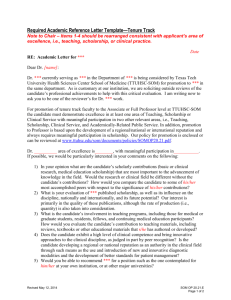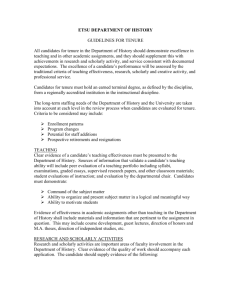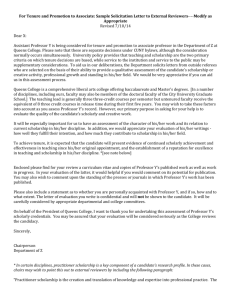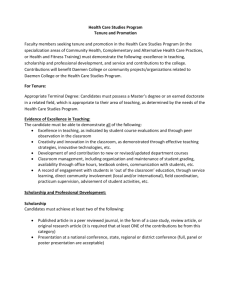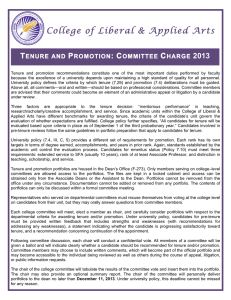10/8/2002 The Ad Hoc Committee on Promotion & Tenure has been... Committee of Faculty Governance with review of the P&T policies...
advertisement
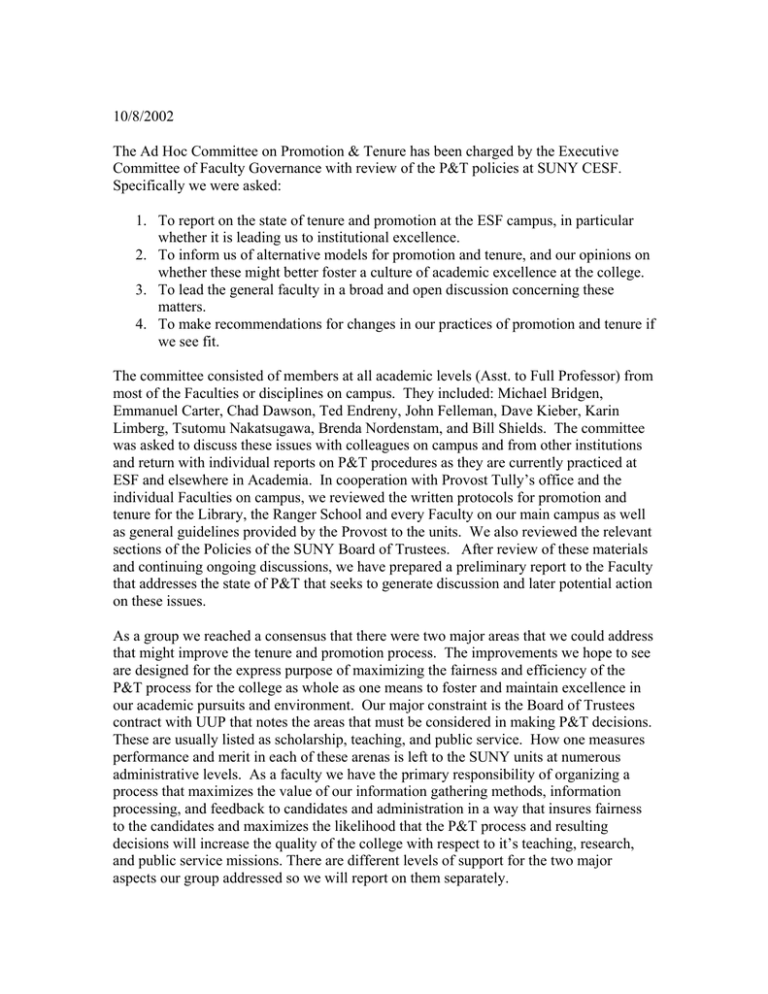
10/8/2002 The Ad Hoc Committee on Promotion & Tenure has been charged by the Executive Committee of Faculty Governance with review of the P&T policies at SUNY CESF. Specifically we were asked: 1. To report on the state of tenure and promotion at the ESF campus, in particular whether it is leading us to institutional excellence. 2. To inform us of alternative models for promotion and tenure, and our opinions on whether these might better foster a culture of academic excellence at the college. 3. To lead the general faculty in a broad and open discussion concerning these matters. 4. To make recommendations for changes in our practices of promotion and tenure if we see fit. The committee consisted of members at all academic levels (Asst. to Full Professor) from most of the Faculties or disciplines on campus. They included: Michael Bridgen, Emmanuel Carter, Chad Dawson, Ted Endreny, John Felleman, Dave Kieber, Karin Limberg, Tsutomu Nakatsugawa, Brenda Nordenstam, and Bill Shields. The committee was asked to discuss these issues with colleagues on campus and from other institutions and return with individual reports on P&T procedures as they are currently practiced at ESF and elsewhere in Academia. In cooperation with Provost Tully’s office and the individual Faculties on campus, we reviewed the written protocols for promotion and tenure for the Library, the Ranger School and every Faculty on our main campus as well as general guidelines provided by the Provost to the units. We also reviewed the relevant sections of the Policies of the SUNY Board of Trustees. After review of these materials and continuing ongoing discussions, we have prepared a preliminary report to the Faculty that addresses the state of P&T that seeks to generate discussion and later potential action on these issues. As a group we reached a consensus that there were two major areas that we could address that might improve the tenure and promotion process. The improvements we hope to see are designed for the express purpose of maximizing the fairness and efficiency of the P&T process for the college as whole as one means to foster and maintain excellence in our academic pursuits and environment. Our major constraint is the Board of Trustees contract with UUP that notes the areas that must be considered in making P&T decisions. These are usually listed as scholarship, teaching, and public service. How one measures performance and merit in each of these arenas is left to the SUNY units at numerous administrative levels. As a faculty we have the primary responsibility of organizing a process that maximizes the value of our information gathering methods, information processing, and feedback to candidates and administration in a way that insures fairness to the candidates and maximizes the likelihood that the P&T process and resulting decisions will increase the quality of the college with respect to it’s teaching, research, and public service missions. There are different levels of support for the two major aspects our group addressed so we will report on them separately. ISSUE 1: Multiple vs Single Protocol With a single exception we all agreed that one desirable enhancement of the P&T process would be to develop a single set of policies and procedures that can be effectively used by every academic unit on campus for all of their promotion and tenure deliberations, recommendations, and decisions. We suggest that, in cooperation with appropriate administrative units, moderate to major changes and streamlining of the procedures currently in place among the different units will make the process more consistent across units and more transparent to the participants. We believe that such changes would facilitate our ability to attract and retain faculty members who would foster a culture committed to academic excellence with obvious benefits to the community. We believe it would do so by making it easier to take the diversity of academic disciplines and faculty members on campus into account during the P&T process, while helping individual faculty meet the process in a well- informed manner. We are open to suggestions on how to accomplish this goal from everyone, but some of our ideas follow as discussion points. . On the basis of our research, we concluded that there are numerous P&T processes that differ, at times substantially, among the academic units on our campus. We decided that a more cohesive process that could and should be used by all of the units would make for a fairer and more efficient process that would benefit the candidates and the college. We were unanimous that a streamlining of the process would be useful and decided to explore specific ideas about how we could effectively streamline the P&T process for everyone involved. Finally, we decided that it would benefit the college if the P&T process was more formally affiliated with the mentoring of faculty at every stage of their career. Some of the ideas floated to achieve these goals included: 1. Generate a college wide policy on the kind of portfolio that should be generated and maintained by all faculty members eligible for reappointment, promotion and tenure. We should make recommendations about what would be included in such a portfolio and how it should be used. We seemed to agree that we are wary of the moving target syndrome and suggested that one immediate improvement would be a written record of what objective goals need to be met and what have been met to be counted as making progress towards promotion and tenure. The written evaluations should be published to candidates, P&T committees at every level, and potentially to peers, formal mentors, and supervisors. In this way the chance of nasty surprise is reduced and the process becomes more transparent. We also believe that to make the process truly efficient, no faculty P&T portfolio should exceed 6 inches in total width. 2. We believe that we should individualize the portfolio and criteria for each candidate to reflect their immediate administrative unit’s mission, in so far as they differ from one another, as well as the college’s requirements for positive decisions in light of each candidate’s talents and interests. This is another way of saying that the most excellent researcher may not be as good at teaching as many of her peers, while the finest and most committed teachers might not be as active in research or public service as others, and that we may, and probably should, decide that both “types” should be promoted and tenured. Such individual differences would improve the diversity of our faculty and the overall excellence of the institution and should be encouraged by the process. We also believe that such individualized criteria should not be made sub-rosa. Rather we believe that the individual’s criteria for P&T should be made in written form to every candidate as explicitly as is possible while still permitting an individual or unit to change them when or if needed. We recognize that the different academic units on campus have legitimate differences in the criteria they might wish to use in such decisions, but we also feel that the relationship between such differences and the college wide criteria should be highlighted openly and explicitly. 3. One method for providing a college wide criteria that permits flexibility that has been proposed and has received support is to make the portfolio and process individual centered. Each faculty member would provide a rationale for their own promotion and/or tenure by highlighting the accomplishments and future plans that they believe make them worthy of promotion or tenure at each level for which they are eligible. They would note how their teaching, scholarship, and public service meet or exceed the requirements published in their own individualized career plan and in the college and board of trustee’s guidelines. They would also make the connection between their performance and the needs and criteria of their home units and the college at large. Many other institutions have been trying to streamline the P&T process and increase the true productivity of their faculty by making accountability more transparent and less susceptible to public relations and purely subjective judgments. One set of possibilities in this area that we briefly discussed included: The publish or perish game has in the opinion of many resulted in a gamesmanship associated with evaluation of scholarship such that many papers of little real value are published in LPU’s, least publishable units to inflate a bibliography. Another problem discussed recently is the multi-authored paper by groups of individuals who put other’s names on papers as authors and receive authorships in return despite little or no critical input into the process. One way to reduce the simple counting of pubs as a scholarship evaluation method is to require that everyone provide in their P&T packet a maximum of what they believe is their 5 most significant publications and why they believe they are significant. Such publications could include the traditional peer reviewed papers or books and also reports to funding agencies, or NGO’s that have a powerful applied impact as long as the faculty member gives a convincing rationale for their inclusion. This would even the playing field across disciplines that publish at different rates and reduces the paperwork needing review by all P&T committees evaluating the scholarship of a candidate. A similar candidate driven self-evaluation of teaching, public service, continuing growth or any other criteria deemed suitable could produce a relatively short and manageable portfolio, if the criteria were carefully thought out and unambiguously listed for each candidate. Individual candidates could then focus on their “best” contributions and most likely or at least intended future contributions to excellence at the college. For example, they could note themselves that their concentration on teaching and the listed work and effort that went into it meant they had less time to seek and get grants for research. By allowing the candidate to decide how to develop their own application for P&T with continuous mentoring from appropriate administrators and peers both before and during the years leading up to reappointment, promotion, and tenure, we will surely have the best picture of the candidate from their perspective and if their plan has been discussed and approved by their administrative unit (chair, department P&T committee) and their college wide peers (e.g., college P&T committee), there should be few surprises. It also leaves flexibility in the process allowing for changes in direction and effort over a faculty member’s career. Finally, the subjective portfolio should be supplemented by objective criteria where possible and when appropriate (e.g., things like citation analysis, number and source of grants and contracts, invitations to speak, etc.) and subjective peer review from outside the usual suspects. For example every P&T evaluation could, and perhaps should include outside letters from peers, some from lists chosen by candidates (what is now done in some units) and some from peers in the field identified by others in that field other than the candidate. For example, a first letter sent to 3 or 4 on a list provided by a candidate could be supplemented by asking responders to recommend others to write letters or simply by evaluating the publications of a candidate to determine who the leaders are in their area of scholarship and asking them. Individuals familiar with teaching and public service should likewise be encouraged to write evaluations. In the end a portfolio that includes a detailed CV, a set of annual reports, a short list of most important publications, most important public service, most important teaching accomplishments, and objective peer reviews of the scholarship, teaching, and public service of a candidate, when combined with a document with the candidate’s own judgment of their most important accomplishments to date and plans for the future in light of their discussions with their mentors, both administrators and faculty peers, could be more efficient and open. Issue 2. College Wide Promotion & Tenure Committee There is a fair amount of support for, and some against, the notion that it could be useful to add a new layer of faculty input to the P&T process at the level of the entire college. We are not making these recommendations because of any deficiencies we have seen in the process locally, but rather as a response to what others in Academia do and why they say they do it. A college-wide P&T process would require appointment of either a standing committee (or alternatively an ad hoc committee for each candidate for P&T) at the college level from the appropriate ranks of the entire faculty, either by the administration or by Faculty Governance (via election or appointment), with terms and term limits to be determined. This College P&T committee would review P&T portfolios submitted by a faculty member at the same time they submit it to their home Faculty (Department) for review. The College P&T committee would make their own independent recommendations to appropriate administrator(s) at about the same time as the home faculty. As the faculty has the charge of providing advice in these circumstances this would provide another level of advice that would be expected to take the view and interests of the entire college faculty into account.. Such college-wide committees are commonplace in academia and are used in other SUNY units and in local colleges and universities such as SU, Cornell, and Cazenovia College. The rationale for such a committee is, in essence, adding another faculty layer of quality control with a different perspective to the P&T process. It is hoped it will: 1. Guard against poor or otherwise unfair departmental recommendations, either positive or negative, based on a potentially less objective process in the home unit (e.g., tenuring nice people because they are nice rather than excellent or not tenuring an excellent person because they do not get along with a Faculty chair or other senior member(s) of a department). 2. Guard against administrative fiat, as we presume it is less likely that a college administrator would ignore a consensus recommendation by both a departmental and college committee than a departmental recommendation alone. 3. Provide guidelines that insure that all administrative units on the campus will be engaged in a substantially similar process leading to P&T decisions, thus facilitating our first recommendation. 4. Provide a college level view that might balance the natural and more department centric view of the smaller academic units. 5. When department and college (faculty) recommendations disagree, it would send a message to relevant administrators- e.g., chair, provost, and president, that their decisions will require great care. Reasons for not considering such a change include a presumption that the extra work entailed would militate against participation by faculty with full plates and would not add much to the current process. A second line suggests that the faculty as a whole and/or administrators at different levels might be against such a change to a degree that could cause serious friction and controversy, should the change be made (Is it worth the risk of getting people angry?). We bring this up for discussion because some feel that such a college level process might be useful to help standardize P&T procedures college wide (i.e., if this committee made independent recommendations about promotion and tenure, individual units would be more likely to follow the college procedures) and because a second independent layer of faculty evaluation would increase the chance for faculty input in the process of directing the college towards excellence. Respectfully submitted, The Ad Hoc Committee
